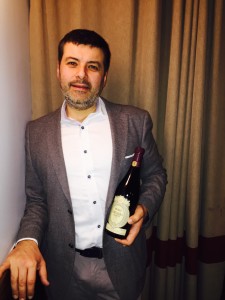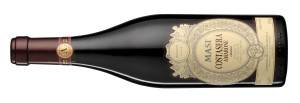
Rafaelle Boscaini
According to Masi Agricola’s press guide, the company takes its name “from ‘Vaio dei Masi,’ a little valley purchased by the Boscaini family in the late 18th century.” Seven generations of Boscainis have made wine in the Veneto. Under the leadership of sixth generation Sandro Boscaini, the company perfected the production of Amarone, and today accounts for 20% of the total production in the Veneto. They’ve also branched out, establishing vineyards in Friuli and Tuscany, as well as a winery in Argentina.
I recently attended a press luncheon with Raffaele Boscaini (representing the seventh generation) at Perbacco restaurant in San Francisco, where we enjoyed Flannery dry aged beef (http://www.flannerybeef.com/) with four Masi wines. The pairing seemed natural enough, as both the grapes and the meat are air dried.

2013 Masianco Pinot Grigio e Verduzzo delle Venezie IGT:
This is a blend of Pinot Grigio from Friuli and the local variety Verduzzo. The Pinot Grigio is picked at the end of August and fermented in stainless steel. The Verduzzo is picked when it is very ripe, towards the end of September, and (like Amarone) dried on racks for a few weeks before fermentation in stainless steel. It’s then transferred to barriques to undergo malolactic fermentation for a few weeks before bottling. It has an aromatic nose of peaches and apricots that follows through to the smooth-as-silk palate. Perfectly balanced — lean, clean and refreshing. $15. 90 points.
For a primer on Amarone, refer to Patricia Guy’s article here: https://epicurean-traveler.com/amarone-in-a-class-by-itself/
2010 Masi Costasera, Amarone della Valpolicella Classico:
An elegant wine with vibrant acidity, dried plums and anise on the nose, dry yet lush on the palate, with flavors that call to mind cherry pie and cinnamon. Perfectly balanced despite 14.9% alcohol.* $55. 91 points.

2008 Masi Riserva Costasera, Amarone della Valpolicella Classico:
A blend of 70% Corvina, 15% Rondinella, 5% Molinara and 10% of the relatively obscure Oseleta. Picked from mid-September to early October, this wine has aromas of plums and cherry pie, with bittersweet chocolate, spice and a warm finish. $68. 92 points
 2007 Masi, Serego Alighieri Vaio Armaron, Amarone della Valpolicella Classico DOC:
2007 Masi, Serego Alighieri Vaio Armaron, Amarone della Valpolicella Classico DOC:
The term Amarone may itself derive from the Vaio Armaron vineyard, owned by the descendents of the poet Dante Alighieri, winegrowers in the Valpolicella zone since 1353. All of that might just be an interesting anecdote, were it not for the spectacular wine the vineyard produces. As is the method for Amarone production, the grapes were dried on racks, losing about 35-50% of their weight by mid-February. About 15% of the Corvina grapes were affected by botrytis, further concentrating the flavor. After fermentation in large Slavonian oak, the wine is aged three years in oak, followed by four months in cherry wood. This method produced a rich, complex wine in 2007. Distinctly raisined in character, it shows layers of baked cherry, dark chocolate, bacon, almond, vanilla and cinnamon. Despite its opulence, at 15.58% alcohol it’s dry and has a long, warm finish. $70. 94 points.
 *A note here about alcohol and Amarone: I have often railed against wines over 14% alcohol, and yet Amarones are, as a class, high alcohol wines. I’ll address this in detail in another article, but suffice it to say that my complaint is with high alcohol wines that purport to be “table wines,” while hiding their alcohol in such fine print that it requires a magnifying glass to see it. Why do I care? Because if it’s high in alcohol, I’ll know to drink less. Sauternes or Port, for instance, are two dessert wines I know will be higher in alcohol, and I will limit my consumption accordingly. Though not a dessert wine, Amarone is likewise designed to be higher in alcohol, so I can make a reasoned judgment about how much to drink. Many Zinfandels, Cabernets and even Pinot Noirs are similarly high in alcohol, without being honest about it, and that’s where I take exception.
*A note here about alcohol and Amarone: I have often railed against wines over 14% alcohol, and yet Amarones are, as a class, high alcohol wines. I’ll address this in detail in another article, but suffice it to say that my complaint is with high alcohol wines that purport to be “table wines,” while hiding their alcohol in such fine print that it requires a magnifying glass to see it. Why do I care? Because if it’s high in alcohol, I’ll know to drink less. Sauternes or Port, for instance, are two dessert wines I know will be higher in alcohol, and I will limit my consumption accordingly. Though not a dessert wine, Amarone is likewise designed to be higher in alcohol, so I can make a reasoned judgment about how much to drink. Many Zinfandels, Cabernets and even Pinot Noirs are similarly high in alcohol, without being honest about it, and that’s where I take exception.
